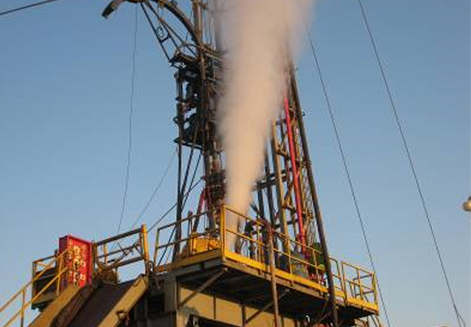Case Study Overview
The subject well was undergoing flowback of fracture proppant when the incident occurred. There was a coiled tubing (CT) injector and quad BOP installed above a TIW valve in the tubing string. A small leak developed in the flow tee, above the TIW valve. An attempt to close the valve was made but was unsuccessful. The valve would not close and the exit point was eroded into a large hole by the flowing frac sand. A junk shot was pumped into the flow tee, at the guidance of CWC, and the original exit point, in the flow tee, was plugged off. However, the TIW valve was cut by the flow and was not able to be plugged.

Situation Upon Arrival
The well was discharging through an elongated cut in the TIW valve. The CT equipment was hanging in the rig blocks and all rig equipment was shut down. All flow was up the tubing with the annulus isolated downhole by a production packer.
Intervention Strategy
diverting the flow. Based on the given conditions, one method gave the least exposure to personnel and would likely allow the shortest time frame for completion. The rig on the well had a two ram BOP stack. The bottom rams would be changed from blind rams to blind/shear rams. The upper rams would be changed from pipe rams to blind rams. The tubing would be sheared with the lower set of rams. A snatch block and a bulldozer would then be used to pull the fast line and raise the CT injector, CT BOPE, and pipe stub above the blind ram cavity. The blind rams would be closed and all flow would be diverted to a flare pit. The well would be diverted due to several shallower zones, formerly isolated by the packer.
Operations
The diverter line was laid out to an existing flare pit already present near the wellsite. The diverting line was made from 7” casing. A coflex line was installed from the BOP choke line valves to a choke manifold, positioned a safe distance from the rig.
The annulus was opened and monitored to ensure that no flow was present before opening the BOP bonnet doors. These doors were opened and the existing rams were removed and replaced with the desired configuration. Blind rams were placed in the top cavity and blind/shear combination rams were placed in the lower cavity. The doors were closed and new seals were installed. The snatch-block was installed on the rig fast line and attached to a bulldozer. The line was pulled just enough to remove all the slack from the cable.
An additional accumulator was brought in an installed for the shearing rams. The rig accumulator would be used for closure of the blind rams after the shear attempt was made.

With all preparations complete, the pipe was sheared off. Flow was immediately visible from the bell nipple after closure of the blind/shear rams. The rig tongs were rigged up to a crane, by way of a sheave, and the pipe was rotated to ensure a complete shear was present. The CT equipment and pipe stub were raised above the blinds by the bulldozer and the blinds were closed. All flow was diverted to the flare pit.